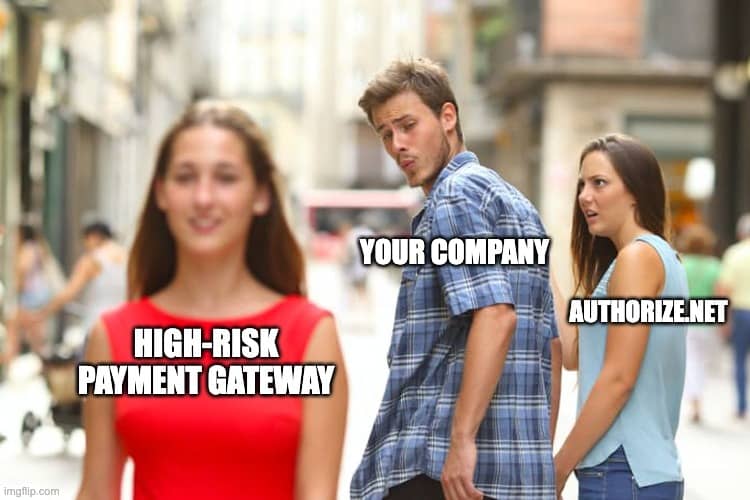Stripe Closed My Account

Payment processors like PayPal, Square, and Stripe are the first choice for most startups and new merchants. But what do you do when they freeze or terminate your merchant account?
Let’s say you own a small clothing store online and have been using Stripe as your payment processor since inception. But lately, things haven’t been going well, and Stripe declines your two most recent payments.
Then, things took a turn for the worse…
…Stripe has locked your account, saying it poses “a higher than average risk of fraud.”
But there’s a bigger problem at hand here: What are your options now? Can you get your money back, or do you have to start from scratch again?
This blog post will cover everything from how to appeal a Stripe termination or freeze to what options you have if Stripe rejects your request.
We can help you save your business and fight for its future (before it’s too late).
What types of merchant accounts does Stripe terminate or freeze?
Suppose your Stripe merchant account is terminated or frozen. In that case, you probably fall into three categories: unauthorized and banned businesses, e-commerce merchants with delivery verification, and high-risk.
If your business is unauthorized, it will be refused any processing by default, which applies to companies like adult content and gambling providers.
The second category of merchants that Stripe terminates includes e-commerce merchants with delivery verification. If your business falls under this category, you will be required to verify your identity and address to process payments.
The third category of businesses that Stripe terminates is high-risk. Unfortunately, the high-risk industry classification for merchants is debatable and vague.
For example, you may start processing payments with Stripe as a regular merchant but end up labeled high-risk at some point.
The probability of being classified in this category increases when:
- You offer digital goods and services that lack physical evidence of product or service delivery (like downloading an app).
- You’re in a high-risk industry where there is an increased likelihood of chargebacks and fraud. Even if you have lower rates than others in your space, larger businesses will likely overshadow yours when deciding where to sell online.
- You run an international company. You’ll be under greater scrutiny because you’re accepting payments from different countries. And, this puts you at more significant risk for potential issues with customers as they are often unable or unwilling to handle those transactions themselves through local banks.
Why do payment processors like Stripe drop a merchant?
There are usually two main reasons why payment service providers suspend a merchant.
The first reason may be that the customer claims they never authorized any purchases from this vendor, and there have been many complaints about them in a short time.
The second reason may be that an acquirer terminated the merchant, either because of high chargebacks or many complaints.
Chargebacks
PSPs (like Stripe) have much to lose if they allow merchants who generate a lot of chargebacks. Chargeback ratios are one metric used by PSPs to measure a merchant’s risk.
They would rather sacrifice their merchant relationships than risk losing business with the banks and credit card companies that make up a considerable part of their revenue stream. Therefore, PSPs will often terminate retailers for any reason at all to maintain good relations between themselves and financial institutions.
A PSP allows marginal merchants who have a 0.2% or 0.3% chargeback ratio to operate. However, they might not be as lenient with merchants with a 0.5%, or a higher chargeback ratio would indicate too much risk.
Customer Complaints
The next thing that could lead to termination is the sheer number of complaints from customers.
The PSP will likely shut down your account if they notice an abnormally high number of complaints about your business compared to other similar companies.
The chargeback ratio and the number of customer complaints may be enough for a PSP to terminate or otherwise restrict your merchant relationship.
They definitely wouldn’t want you on their network, but it takes one more thing for them to take decisive action: volume. A retailer with low processing volume may lead to termination by some PSPs because they deem the volume too small to offset any risk associated with this merchant.
Financial Damage and Bad Reputation
If a PSP faces excessive chargebacks, they can lose their account with Stripe (and any benefits of expanding that platform). Then, to cover the damages incurred by such frauds, they must pay from their pocket.
More so, if Stripe has to cover the damages resulting from the chargebacks, they keep all of the merchant’s funds on their account.
One way a payment processor reduces this risk is by requiring bank accounts. It offers them some form of protection in case something goes wrong.
For example, suppose money vanishes into thin air before being returned to its rightful owner. In that case, there’s another source from which funds could be recovered (through a refund or other means).
Stated differently, a PSP would lose all of its money while paying additional costs for fraudulent transactions and an account suspension with no warning whatsoever, leading to bankruptcy (or worse).
Another serious consequence of these random fluctuations is that PSPs cannot plan their business costs accurately. As a result, they lose control over how much money should remain available in their accounts at any point in time — this can result in insufficient funds when needed.
In some cases, a PSP’s bank will freeze or terminate the account due to suspicious activity (such as large amounts of money being wired in and, soon after, a notice from Stripe that the merchant account has been terminated).
How does Stripe close merchant accounts?
Stripe has a reputation for closing accounts without warning or explanation. In addition, customer service is non-existent, and Stripe promises to respond within 24 hours but often does not, according to reviews.
The company explains that “account closures are rare” and only happen as a last resort when other attempts fail. But, if you look closely at recent cases, the merchant was approved for an account set up for processing transactions only to be canceled later with no warning. There can be no recourse and no one to speak to at Stripe.
The merchant may be notified via email and has thirty days to show the activity that triggered the shutdown was false. This may mean presenting evidence proving transactions are permitted under their terms of service.
If this doesn’t happen within 30 days, Stripe states it “will attempt to return any unused funds held in your account less any fees owed.” But if you continue to receive notices from your customers — even after providing proof — they may continue to withhold your funds.
What to do when your Stripe account gets terminated and your funds are frozen?
- If your merchant account gets terminated or frozen, you need to take action as soon as possible. You may not have a lot of time before the money in your Stripe account is gone for good.
- Here are a few things you should do:
- Contact customer support and find out why Stripe has terminated your account. Perhaps it’s because of an error on your end that can be fixed quickly with some help from Stripe.
- If you cannot get reinstated, contact any affected customers immediately so they know about the situation. They’ll then be able to decide if they want to keep paying you through another payment processor (e.g., PayPal).
- File an appeal if you disagree with Stripe’s decision to terminate your account.
- If the appeal fails, remove any sensitive customer information you have collected from your website. Contact a lawyer for legal help if you think the termination is unfair or violates any terms you agreed to when signing up for the service (see Stripe’s Terms of Service).
- Contact another payment processor like PayPal (which has similar fraud prevention measures), Dwolla, or Balanced Payments.
- Finally, determine whether Stripe owes you money before it gets transferred to its holding account. Funds are typically in limbo for at least two weeks before you can move them.
How do you start accepting payments after Stripe terminates or freezes the account?
If your account is terminated or frozen by Stripe, there are steps you can take if you want to accept payments again.
Set up a new merchant account through another provider
One option is setting up a new merchant account through another provider like PayPal or Square. Still, before doing so, it would be best to discuss the issue with a high-risk merchant account specialist who understands the intricacies of credit card processing.
Here’s how to do this step-by-step:
- Request a Terms & Conditions agreement from another credit card processor.
- Submit a reinstatement fee of $50 (which is non-refundable) and agree to any other fees that may be associated with your second merchant account.
- Contact support via phone or email to re-establish your relationship with Stripe as a trusted business partner.
- Provide all necessary documents requested by Stripe to bring your account back into good standing. This typically includes a copy of your business license, articles of incorporation or association, and sometimes an updated credit report.
- Work with Stripe support staff to meet the re-entry criteria, which can include specific volume limits (i.e., a $10,000 monthly transaction limit) or agree to all previously imposed limitations on your account (like once-a-month deposits).
- Once you have met the re-entry criteria and reinstate your account, follow up with Stripe support staff to fulfill any contractual obligations before your termination. An example of this would be issues related to chargebacks.
Bring your account back into good standing.
Another option is to bring your account back into good standing with Stripe. You’ll need to have a business bank account ready and waiting to link your Stripe account.
To get started, request a review of your dormant account by submitting the following form: https://www.stripe.com/contact-us.
You’re also encouraged to email help@stripe.com with any additional support requests or questions you may have about this process.
When the form is submitted, be sure to reply to confirmation emails from Stripe. So that they know it’s coming from an authorized source instead of a random person on the internet who has emailed them pretending to be you (which happens sometimes). There should be no reason for them to deny your return attempt if all of the information in the form is accurate and true.
You will be required to submit a range of information for verification purposes (if you’re not already verified), including your company’s DUNS number, business bank account, and more. You can find a list of verification requirements can here: https://stripe.com/us/faq#what-is-verification.
This process may take as little as 24 hours or as long as several weeks, depending on how long it takes Stripe to get in contact with you about the required information. And whether or not they have any questions at all.
Once Stripe reactivates your account after passing these security measures, you are allowed to proceed with using Stripe again, just like before!
You can resume online payments with your preferred payment gateway, website, etc., without any issue (aside from going through this process in the first place).
If you haven’t already canceled your account before it was suspended or terminated by Stripe, now is probably a good time to do that. But, first, make sure you have access to all of the information required for cancellation and that you’ve saved any information you might need if/when the account is reactivated.
Note: If your account was closed due to violating their terms of service policy, they will likely not be willing to bring it back (even after following these steps).
There’s nothing you can do about this other than try to avoid doing something to get your account terminated again in the future.
You may be required to provide additional information before Stripe reactivates your account, depending on why it was previously taken down or suspended.
For example, suppose you’ve made a mistake by accident and are now willing to comply with security measures that Stripe has set forth. In that case, they should consider this when reviewing your case, even if they typically would not have done so otherwise.
What to do if Stripe blacklists you?
If you end up having your account on Stripe’s blacklist for any reason (even if it’s an outdated blacklist entry), make sure you submit a removal request.
Tell them about yourself and what happened so that they can manually check everything themselves before making a decision.
Go to this form to submit a removal request: https://stripe.com/help#removal-requests.
However, it does not guarantee that they will keep or remove your account information from their blacklist(s).
Keep in mind that your entry may remain on their databases regardless of whether or not the status remains personally set to “debarred.”
This process is beyond Stripe’s control, so they try to respond as quickly as possible, allowing up to one week at most, though usually, it’s less than that.
Note: If Stripe can still not accept your account back into good standing, you’ll need to reach out to them again after some time has passed (a few months or so). In most cases, they can see your side of the story and re-evaluate your resubmission application.
But in rarer cases, they may not be willing ever to allow you back onto the platform. Since this doesn’t happen often, this can be prevented by simply explaining yourself better/more frequently instead of waiting until something goes wrong.
This option may seem like the best one if you don’t want to lose an established business or any hard work that you’ve put into it already.
The important thing is being candid about what happened and how everything took place. Then, they may eventually come around and see your side of things while giving you another chance at using their web platform.
What else can you do?
Here are just a few other things that you could do (which may or may not be applicable in your case):
- Contact them through Facebook – Stripe is relatively active on their Business page. In addition, they often reply to people who send private messages this way.
- Stop using your payment processor in the meantime and focus on completing whatever debt you still have left over with Stripe. Keep in mind that this shouldn’t take longer than a month at most.
- If it isn’t possible to get a loan, consider selling some of your assets or gear to catch up on all of the payments when your account was frozen. Of course, this isn’t always the best solution, but it might be worth a try.
- Make sure that you follow all of Stripe’s policies and guidelines as strictly as possible so that you never run into any trouble in the future and there aren’t any surprises.
- You may also want to keep an eye on your page for unusual activity or stolen payment information, just in case, someone gets access again somehow (this can be set up quickly with specific web plugins).
What about other payment processors?
If you can’t get your Stripe account back, there are alternatives available. For example, Paypal is a leading alternative. Startups often use it because it’s easy to set up and integrate with other services like Google Analytics or Shopify.
Square also offers an online credit card reader, making it easy to accept payments without buying expensive hardware or software.
In addition, all these companies are PCI compliant, so they offer protection against fraud and data breaches.
What if I don’t want a traditional payment processor?
In that case, there are other alternatives available, like Bitcoin, that offer more flexible payment options.
One solution is Bitpay – which works with numerous alt-coins (i.e., not just Bitcoin). Coinbase offers similar services, though they only support Bitcoin at the moment (at least in most regions).
Conclusion
Stripe is a business, not an innocent bystander. They are allowed to terminate your account for any reason they see fit with no explanation or notice whatsoever. Take the time to read more about their policies before you try using their services to avoid any misunderstandings along the way.
If Stripe does freeze or terminate your merchant account, it’s possible to slowly regain Stripe’s trust over time if you explain your situation.
If none of these options work and it seems like there is no way for you to get back into good standing with Stripe, then the best thing to do would be to look for other payment processors. For example, it’s easy to get approved for a high-risk merchant account by filling out the form on this page.
Our Zenti team members are experts in handling merchant payment processing for a variety of high-risk industries. We specialize in adult merchant accounts, offshore merchant accounts, bad credit merchant accounts, CBD merchant accounts, and other high-risk merchant accounts.
We’re here to help high-risk businesses get approved and stay approved for merchant accounts, increase revenue, lower their chargeback ratio, and prevent fraud.
Our team will find you the right payment processing solution to fit your business.
We hope this article has helped provide a guide to what you should do if you’ve had your Stripe account suspended or terminated for any reason.
Questions?
Great!
That’s what we’re here for.
Helping companies like yours is what we do!
Let’s chat.
Read Next

Find out whether Authorize.Net works for high risk merchants, what restrictions you might face and how to get approved.

Get expert advice on selling CBD products on Shopify, including compliance tips and setting up secure payment options.

Find out why Square may deactivate merchant accounts and steps to resolve issues and maintain uninterrupted payment services.
Need a High-Risk Merchant Account?
Disruption-free payment processing at the best price for your situation, guaranteed.
Get Free Guidance Now!